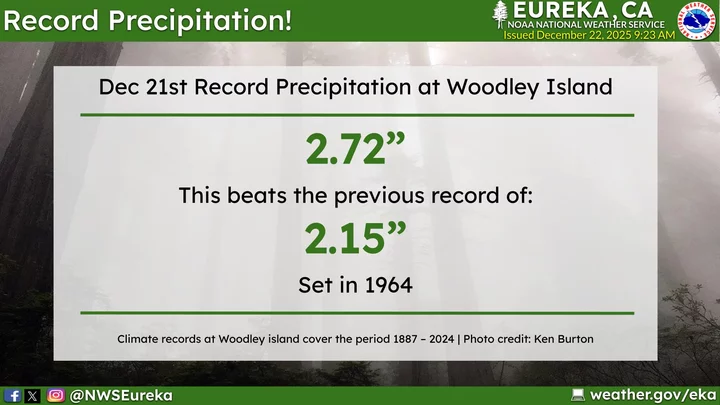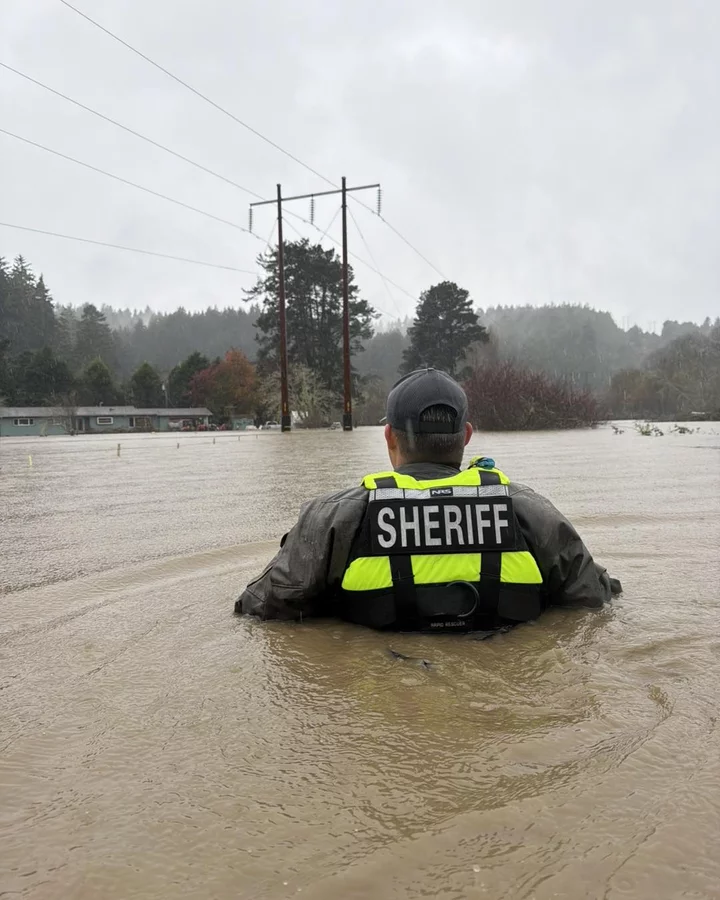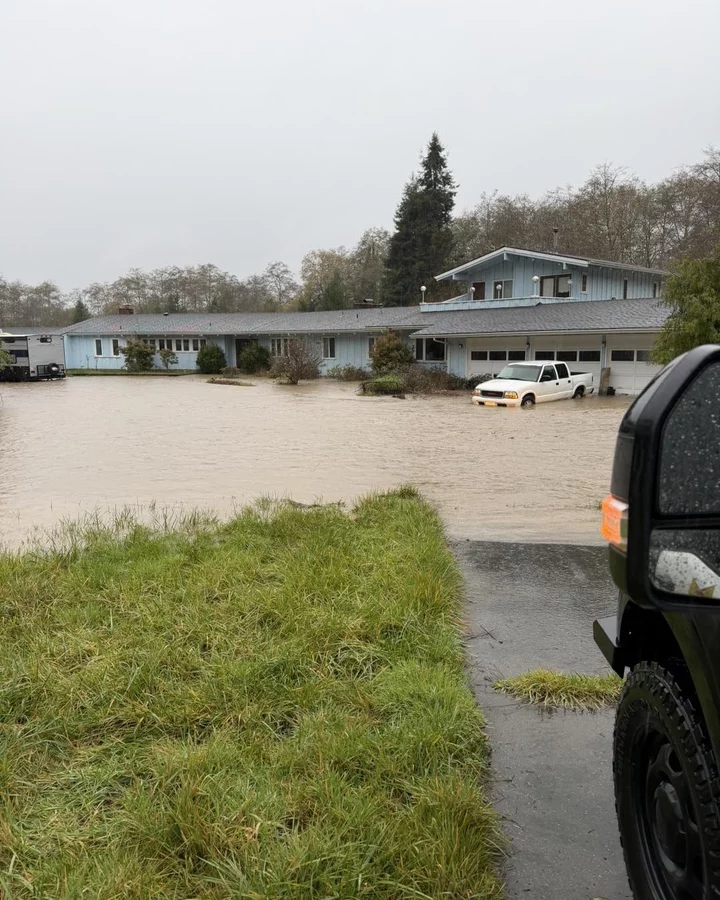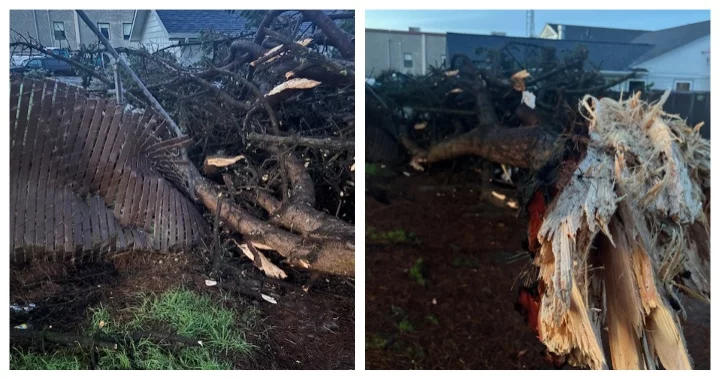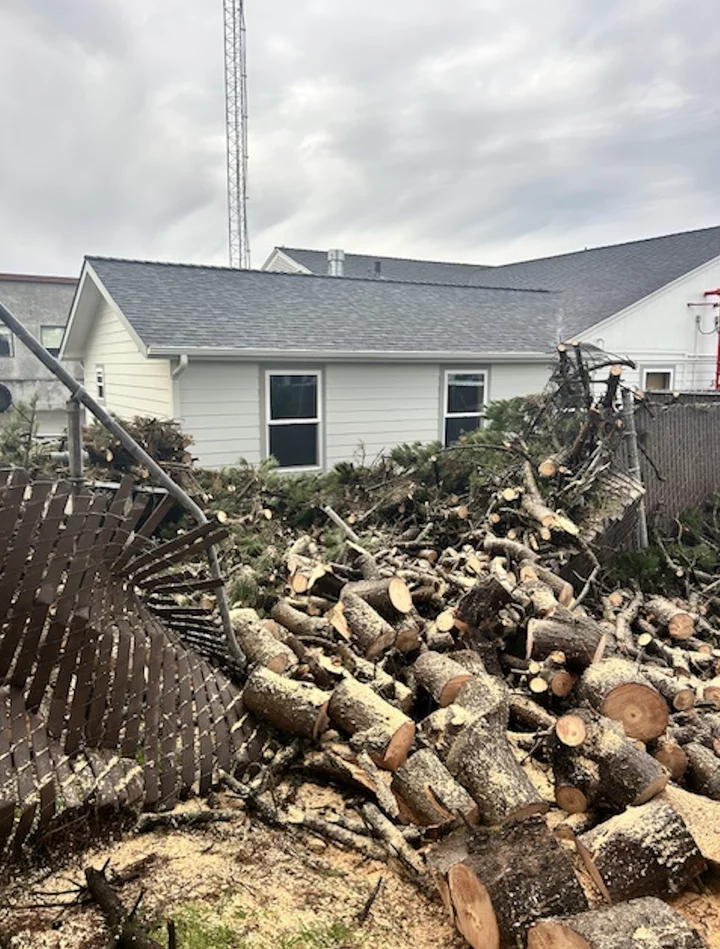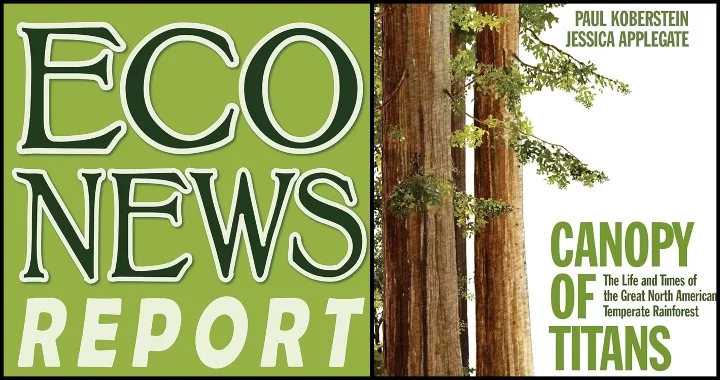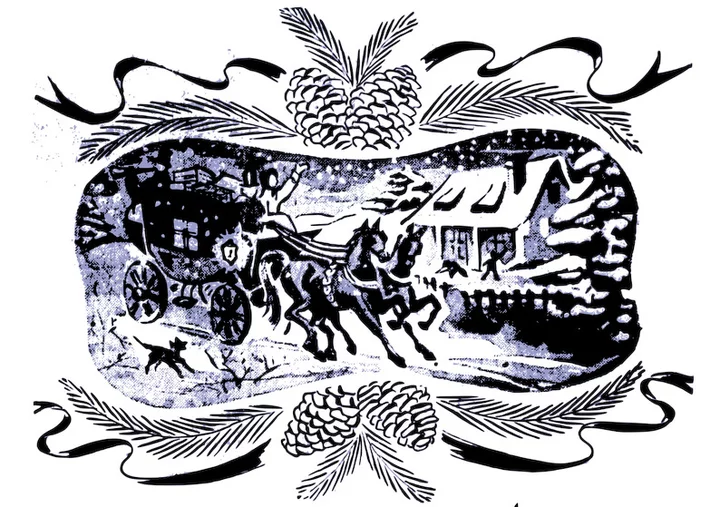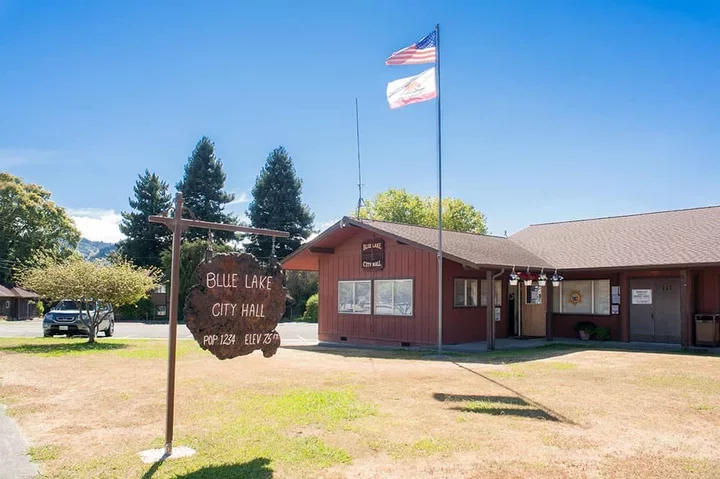RECORD BREAKER: Eureka Just Had Its Rainiest Dec. 21 Since the Christmas Flood of 1964
Isabella Vanderheiden / Monday, Dec. 22, 2025 @ 10:33 a.m. / How ‘Bout That Weather , News
Graphic: Eureka NWS
###
Dec. 21 has never been so wet! Our friends at the National Weather Service (NWS) office in Eureka say Sunday’s deluge broke the Dec. 21 rainfall record on Woodley Island with 2.72 inches of rain. The last time it rained that much on Woodley Island — or nearly that much — was during the Christmas Flood of 1964.
More rain is on the way tonight! A flood watch will remain in effect through Friday. The NWS says we can expect another four to eight inches of rain between now and then.
Stay dry out there, folks!
BOOKED
Today: 4 felonies, 8 misdemeanors, 0 infractions
JUDGED
Humboldt County Superior Court Calendar: Today
CHP REPORTS
No current incidents
ELSEWHERE
County of Humboldt Meetings: Behavioral Health Board Executive Committee Meeting - Nov. 5, 2025
Governor’s Office: One year after Los Angeles firestorms, California continues statewide recovery and behavioral health support
Fishing the North Coast : Dry Stretch Sets the Stage for Prime Steelhead Conditions
Governor’s Office: Governor Newsom delivers final State of the State Address, honoring California’s past and reaffirming a brighter future for all
(UPDATE) Flood Watch to Remain in Effect Through Friday; Hwy. 101 Reopened in Both Directions
Ryan Burns / Monday, Dec. 22, 2025 @ 8:19 a.m. / How ‘Bout That Weather
UPDATE, 4 P.M.: The Humboldt County Department of Public Works issued the following update on local road conditions:
The following roads are flooded:
- Howard Heights
- Cannibal Island Rd .10 mile from Eel River to end of road
- Graham Rd
- Zanes Rd
- Berta Rd
- Old Arcata Rd between Graham Rd and Jacoby Creek Rd
- Eel River @ Hookton – road is muddy and slippery
- Ambrosini Lane
- Rose Ave
- Fernbridge Dr Northbound Lane
The following roads are closed:
- Port Kenyon is closed between Market and California
- Hookton Rd is closed between Tompkins Hill Rd and Highway 101 due to the flooding.
- Mad River Rd is closed at P.M. 2.75 (Tye City) due to flooding
- Goble between Fulmor and Hwy 211
- Camp Weott at Dillon
- Fulmor from Goble to the end
- Glendale Drive - 100 feet northwest of Liscom Hill Rd closed due to flooding
- Redwood Dr from Evergreen Rd to Bear Canyon Rd closed due to a slide
- Fernbridge Dr Northbound Lane closed to the bridge due to flooding
- Coffee Creek is closed due to flooding from P.M. 1.00 to 1.25
- Meridian Road closed between P.M. .5 to .9
- Wilder Ridge Rd at P.M. 6.9 closed due to flooding
- Crannell Rd is closed at Dows Prairie Rd due to flooding
- Waddington Rd from Pleasant Point Rd to Substation Rd
- Goble Lane from Fulmor to Hwy 211 closed
- Nissen Rd from Goble Lane to the end closed
- Dillon Rd
- Sage Rd from Goble to the end
- Goble between Dillon Rd and Nissen Rd
Drive safely. Road conditions will be updated as soon as they become available.
###
Original post: The waterlogged lowlands of Humboldt County have drained a bit overnight, allowing local roads and highways to reopen. (Hwy. 101 reopened yesterday evening; SR 211 into/out of Ferndale and Avenue of the Giants are open to one-way traffic.)
Water levels have also begun to recede in local rivers. The Mad reached moderate flood stage Sunday afternoon, and the Eel remains in moderate flood stage as of this writing, though it peaked in the wee hours and is now on its way down.
However, the entire North Coast region will remain on flood watch through Friday evening, according to the National Weather Service.
Here’s more info from that agency:
FLOOD WATCH IN EFFECT FROM THIS EVENING THROUGH FRIDAY EVENING…
- WHAT…Flooding caused by excessive rainfall is possible.
- WHERE…Del Norte County, Humboldt County, Trinity County, Mendocino County, and Lake County.
- WHEN…From this evening through Friday evening.
- IMPACTS…There will be an increased risk of rock and land slides along roadways. Excessive runoff may result in flooding of rivers, creeks, streams, and other low-lying and flood-prone locations. Creeks and streams may rise out of their banks. Flooding may occur in poor drainage and urban areas. Area creeks and streams are running high and could flood with more heavy rain.
- ADDITIONAL DETAILS… Additional rounds of heavy rain are likely again starting tonight and continuing through Friday night. An additional 4-8 inches of total precipitation is possible through Friday. There will be breaks in the heavy precipitation, but heavy rain falling on
already saturated ground will promote flooding impacts. Additional precipitation amounts of 4-8 inches are possible through Friday.- PRECAUTIONARY/PREPAREDNESS ACTIONS…
You should monitor later forecasts and be alert for possible Flood Warnings. Those living in areas prone to flooding should be prepared to take action should flooding develop.
[UPDATE: 101 NORTHBOUND CLOSED] WATERWORLD: Widespread Flooding is Closing Area Roads and Prompting Emergency Rescues for Trapped Residents
Ryan Burns / Sunday, Dec. 21, 2025 @ 11:06 a.m. / Emergency , How ‘Bout That Weather
UPDATE, 3:28 p.m.:
One southbound lane of Hwy. 101 has been reopened. Still no estimated time for reopening the northbound lanes.
###
Hwy. 101 north of Loleta shortly before it was closed. | Photo via Caltrans.
###
UPDATE, 1:18 p.m.:
Hwy. 101 is now fully closed from just north of Loleta Drive to the Tompkins Hill Road overhead bridge near College of the Redwoods. Video from First District Supervisor Rex Bohn:
###
UPDATE, 1:12 p.m.:
And now northbound 101 is fully closed from the bottom of the hill a quarter mile north of Loleta Drive to Tompkins Hill Road. No estimated time of reopening.
###
UPDATE, 12:53 p.m.:
Add State Route 36 to the list of road closures. Flooding is, of course, the culprit, and there’s currently no estimated time of reopening.
###
Original post:
A member of the Humboldt County Sheriff’s Office Swiftwater Rescue Team approaches a residence in Freshwater. | Photos via HCSO.
###
Rain is wreaking havoc across Humboldt County today, leading to widespread flooding in Freshwater and the Eel River Valley, creating dangerous driving conditions on area roads and prompting emergency rescue efforts for stranded residents.
Flash flood warnings are in effect across the northern and southern portions of the county. In fact, the whole county has been placed on “Flood Watch” status by the National Weather Service.
The Humboldt County Sheriff’s Office Swiftwater Rescue Team is actively helping flooded residences in the Freshwater area, as seen in the photo above. The office advises people to shelter in place, if possible, and dial 911 if you’re experiencing a safety emergency, of course.
“Do not attempt to cross flooded roadways or moving water on foot or in a vehicle,” the Sheriff’s Office says. “The water is extremely swift and cold and can quickly become overwhelming and life threatening.”
State Route 211 leading into and out of Ferndale is currently closed, as is Avenue of the Giants (State Route 254).
The Eel River is forecasted to reach flood stage by 9 p.m. and continue through Monday evening, peaking at 22.5 feet at around 5 a.m. Monday.
The Mad River is expected to reach minor flood stage around 5 p.m. with a peak of 22 feet.
According to the Humboldt County Sheriff’s Office, the following roads were flooded, as of about 11 a.m.:
- Howard Heights between Kneeland and Howard Heights Road
- Hookton Rd west of Tompkins Hill Road
- Myrtle Ave at Freshwater Road
- Old Arcata Rd between Graham Rd and Jacoby Creek Road
- Graham Road
- Zanes Road
- Crannell Road
- Berta Road
- Glendale Drive - 100 feet northwest of Liscom Hill Road
- Ambrosini Lane
- Waddington Road between addresses 2400 and 2504
And the following roads have been closed:
- Eel River Road and Hookton Road is closed due to flooding
- Old Arcata Road between Graham Road and Jacoby Creek Road is closed due to flooding.
- Freshwater Road between Greenwood Heights Drive and Garfield School is a HARD CLOSURE due to flooding. Use the detour through Greenwood Heights Drive to get to the Kneeland area.
- Elk River Road 1/2 mile before Wrigley Road is closed due to flooding
- Fernbridge Drive Northbound Lane closed to the bridge due to flooding.
- Coffee Creek is closed due to flooding from P.M. 1.00 to 1.25
- Meridian Road between post marker 0.5 to 0.9
Stay safe out there, folks.
Humboldt Bay Fire Station in Eureka Closed After Fallen Tree Cuts Off Gas and Power, Damages Building and Disrupts Communications
LoCO Staff / Sunday, Dec. 21, 2025 @ 11 a.m. / How ‘Bout That Weather
Photos via Humboldt Bay Fire.
###
Press release from Humboldt Bay Fire:
Humboldt Bay Fire (HBF) regrets to announce the temporary closure of Fire Station 3, located at 2905 Ocean Ave., in Eureka for the unforeseeable future following significant damage caused by recent winter storm.
A fallen tree impacted the station, resulting in the loss of gas and power, as well as structural damage to the station. The incident has also disrupted communications, as Station 3 houses key radio repeater equipment critical to operations in the central area of the City of Eureka.
To ensure uninterrupted emergency response, personnel from Station 3 have been temporarily reassigned to HBF’s four remaining fire stations as well as mitigated all communication issues.
Humboldt Bay Fire is committed to maintaining the high level of service our community expects and deserves. HBF is working closely with partners, including Eureka Police and Fire Dispatch and Pacific Gas & Electrical (PG&E), to assess the damage, restore utilities, and safely return the station to full operation as quickly as possible.
As a safety reminder during these ongoing winter storms, residents are urged to stay clear of downed power lines and report them immediately by calling 911 for emergency response. Humboldt Bay Fire appreciates the community’s understanding and support during this time.
We wish everyone a safe and happy holiday season. For more information, contact:
Humboldt Bay Fire
533 C Street, Eureka, CA 95501
Phone: (707) 441-4000
Email: Infor@hbfire.org
Website: www.hbfire.org
THE ECONEWS REPORT: The Temperate Rainforests of North America
The EcoNews Report / Saturday, Dec. 20, 2025 @ 10 a.m. / Environment
The temperate rainforests of the Pacific Northwest, stretching from Alaska all the way down to the redwoods of California, are some of the most productive and biodiverse forests on the planet. In terms of total carbon sequestration and storage, nothing beats them — particularly the towering coast redwoods. In this climate crisis, the best thing we can do is to grow these forests older, safely storing carbon away.
But there is a concerted effort by the timber industry to offer a different “solution:” cutting down trees to store carbon in wood products.
Environmental journalist Paul Koberstein, author of the book Canopy of Titans, joins the program to discuss the magnificence of the temperate rainforests of North America and his reporting on greenwashing of timber operations in the name of the climate.
###
HUMBOLDT HISTORY: Let Charity Sweeten the Chalice
Bret Harte / Saturday, Dec. 20, 2025 @ 7:30 a.m. / History
NOTE from the HUMBOLDT HISTORIAN: This editorial appeared in the Northern Californian on December 21, 1859, at the time when Bret Harte was employed on this paper. It was reprinted in the Newsletter (the predecessor of the Humboldt Historian) in December 1956, with a note from Martha Beer Roscoe that stated, “We are convinced, through stylistic evidence, and through comparison of it with articles known to have been written by Bret Harte during this period, that this editorial came from his pen. We have read many excellent editorials written by the able, but matter-of-fact Colonel Whipple, and so feel reasonably sure that this could have been written only by Bret Harte.”
###
The annual season of festivity and enjoyment is at hand. Not as of old, with its crisp snow, its ringing sleigh bells, its icy airs, its bewildering shows, and fascinating shop windows. Not as remembered by the western wanderer in his memories of eastern homes, yet blessed as the anniversary of such memories. A few weeks, and old Christmas will be laid away in one of Time’s niches, as carelessly as its broken toys, and favored gifts, no longer new, are tossed upon the closet shelf. But we pity the man who can look back on such days without regret, or can open the dark closet of his memory without a sigh over its broken baubles. We have a proper respect for manliness, yet how many of man’s full-grown hobbies have their shattered prototypes on those same forgotten shelves!
It’s an old saying that “Christmas comes but once a year.” Take it as a popular excuse for an annual Saturnalia, for the unrestricted indulgence of animal appetite, for gluttony and drunkenness, and let us be thankful that it comes but “once a year.” But take it as the blessed mediator of estranged affection, recalling the past, reviving old loves and friendships and kindling and awakening new; bringing friendliness and generosity, “peace on earth and good will towards men;” recalling in deed as well as name the advent of the meek and holy One — and heaven knows it comes too seldom!
Here in this favored land, in the new homes you have built, in the land of strangers and wanderers, in the region of “tarrying,” of inquiet and unrest, as you gather round the social board, — “THINK OF THE ABSENT!”
Think of the ties, once sacred, broken and disregarded. Think of the friendships that have grown cold by neglect and absence. Think of the distant ones, whose hearts might have been gladdened by slight remembrance, or the potent magic of a kindly letter. Think of them at their best. The old true faith, the honest simple hearts, unchilled by fortune, and unchanged by time.
Sons and daughters, think of the gray heads and bowed figures in different lands — but close to the one undefined country — think of the dim eyes that gaze wistfully at the vacant chair, and the trembling lips and broken accents that couple your name with a parent’s blessing. Parents, think of the unexperienced souls launched on the ocean of Life, — how many have been sucked into the giddy vortex of deceit and folly, how many have foundered in sight of port, how many tossed about by contending elements, rudderless and alone, lit up by fiery passions, have drifted like a blazing ship, into outer darkness. Think of the snares that trip the nimblest feet, and how the fatal sisters’ shears have severed many a silken thread on which your neighbor wove the web of future fancy. Think how the great white shore of Eternity, with its bleaching skeletons of mighty ships, is yet strewn with the wreck of many a fairy shallop.
Think of those who have no home. Think of those who have no kith or kindred. Think what it is, at such a season, to sit alone, apart from the sacred circles, with no fellowship or sympathy, isolated and secluded, with no gentle hand to touch the heart strings, no one to know its secret compass, no one to draw out its hidden latent melody. There are such around you everywhere. Every little hamlet in California contains such strange and voiceless heart-chords, unknown, unswept, but not unmusical.
Think of this at the recurrence of each festivity. Then “eat, drink, and be merry.” We are not moralizing, nor do we hold ourself strictly “virtuous;” nor would we keep any from their “cakes and ales,” but we believe that the feast leaves no headache behind, when Memory sits at the board and Charity sweetens the chalice.
###
The piece above was printed in the Winter 1997 issue of the Humboldt Historian, a journal of the Humboldt County Historical Society. It is reprinted here with permission. The Humboldt County Historical Society is a nonprofit organization devoted to archiving, preserving and sharing Humboldt County’s rich history. You can become a member and receive a year’s worth of new issues of The Humboldt Historian at this link.
Blue Lake Set to Appoint Civil Engineer, Third-Generation Local Jennie Short as Next City Manager
LoCO Staff / Friday, Dec. 19, 2025 @ 5:38 p.m. / Local Government
Blue Lake City Hall. | Image via the City of Blue Lake.
###
Press release from the City of Blue Lake:
At their regular December 23, 2025 meeting, the Blue Lake City Council will consider the selection and appointment of Jennie Short as the new City Manager. Should the Council move forward, Ms. Short will take over from interim City Manager Jill Duffy who has served the city since last August. The leadership transition is expected to commence on January 5, 2026.
I am excited that the Council will have the opportunity to consider Ms. Short for City Manager and, if so appointed, I am confident that she will be an excellent leader for our City and our residents” said Mayor John Sawatzky.
The recommendation of Ms. Short follows a robust recruitment process lead by the City Council with the help of an ad hoc committee and independent recruitment firm over the past five months. With nearly three decades of experience in engineering and project management, Ms. Short has a proven record of managing in infrastructure projects that have improved essential services such as water supply, sewer collection and treatment, airports, and transportation. Her knowledge in regulatory compliance, fiscal management, and enterprise fund financial management further enhances her ability to advance the city’s objectives while maintaining transparency and accountability.
Ms. Short grew up in Blue Lake and graduated from Chico State University with a bachelors of science in Civil Engineering. She has worked as a civil engineer with the State of Oregon’s Department of Transportation, the US Forest Service, the City of Roseburg, Del Norte County and the local consulting company 4J’s Consulting. Following a return home to Blue Lake in May 2007 she has served on the city’s Parks and Recreations Commission and the Blue Lake/Fieldbrook Little League Board of Directors.
“As a third-generation Blue Laker, I cherish this special community and the charming characteristics that embody Blue Lake.” States Ms. Short. “It is an honor to be in a position where I can utilize my unique skill set to enhance core services such as infrastructure, public safety, and financial stability. I am grateful for this opportunity and, if appointed, look forward to working with the council, staff, and residents to achieve our common goals.”

